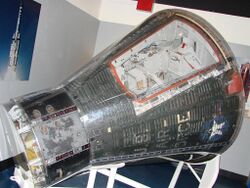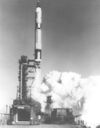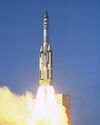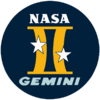Engineering:Gemini spacecraft No. 2
| Gemini SC-2 | |
|---|---|

| |
| Gemini no. 2 on display | |
| Role | Space capsule Test article |
| National origin | United States |
| Type | Geminivand Gemini B spacecraft prototype |
| Manufacturer | McDonnell |
| Construction number | 2 |
| Manufactured | 1964 |
| First flight | Gemini-Titan 2 (19 January 1965) |
| Last flight | MOL Gemini-B 1 (3 November 1966) |
| Flights | 2 |
| Status | Display |
| Fate | Museum exhibit |
| Preserved at | National Air & Space Museum |
Gemini spacecraft No. 2 (officially known as "Gemini SC-2", for "space capsule 2") was the second NASA Project Gemini full-up space capsule built. This McDonnell Gemini capsule was the first spacecraft to be reused, flying twice into suborbital space. No.2 flew on missions Gemini-Titan 2 and Manned Orbiting Laboratory Gemini-B flight. The capsule is currently on display at the Smithsonian Institution, in Washington, D.C..
Spacecraft history
The capsule is part of the collection of the National Air and Space Museum of the Smithsonian Institution.[1]
On 19 January 1965, the Gemini-Titan 2 suborbital test mission was launched, with the second prototype Gemini capsule.[2][3]
In March 1965, NASA approved the transfer of the Gemini 2 capsule to the USAF for modification into the first prototype of the Gemini B capsule.[4]
On 3 November 1965, the first Manned Orbiting Laboratory (MOL) and Gemini B suborbital test mission was launched.[4] Thus, it became the only Mercury, Gemini, or Apollo, capsule to be reflown,[5] and the first capsule to ever be space-reflown.[6]
The capsule was transferred to the Smithsonian Institution, as part of the National Air and Space Museum collection.[1]
The capsule was put on display in the Allan and Malcolm Lockheed and Glenn Martin Space Gallery at the National Museum of the USAF in 2016.[1]
The capsule was put on display in the exhibit hall of the Air Force Space and Missile Museum of the USAF in 2017.[2]
Flight history
| Flight # | Mission | Launch date (UTC) | Liftoff | Landing | Notes | |
|---|---|---|---|---|---|---|
| 1 | Gemini-Titan 2 | 1965-01-19 19 January 1965
|

|

|
NASA Mission | [2][3][4] |
| 2 | Gemini-B MOL test mission | 1966-11-03 3 November 1966
|

|
USAF Mission; first spacelaunch reuse of a previously spacelaunched vehicle | [2][3][4] |
See also
- Falcon 9 booster B1021, the first SpaceX Falcon 9 stage one booster to be reused for a spacelaunch mission
- SpaceX Dragon C106, the first SpaceX Cargo Dragon V1 capsule to be reused for a spaceflight mission
- Scaled Composites SpaceShipOne
- McDonnell Douglas DC-X
- Blue Origin New Shepard
- NASA STS Space Shuttle
References
- ↑ 1.0 1.1 1.2 USAF (4 April 2016). "Gemini Spacecraft". National Museum of the U.S. Air Force. http://www.nationalmuseum.af.mil/Visit/Museum-Exhibits/Fact-Sheets/Display/Article/198109/gemini-spacecraft/.
- ↑ 2.0 2.1 2.2 2.3 USAF (2017). "Gemini Capsule". Air Force Space and Missile Museum. http://afspacemuseum.org/displays/GeminiCapsule/.
- ↑ 3.0 3.1 3.2 "Gemini-B: NASA-Gemini's Air Force Twin". Historic Space Systems Infosheet (Historic Space Systems) (1). September 1996. http://www.space1.com/pdf/news1096.pdf.
- ↑ 4.0 4.1 4.2 4.3 Amy Shira Teitel (3 November 2015). The Manned Orbiting Laboratory the Air Force Failed to Launch. Popular Science. https://www.popsci.com/manned-orbiting-laboratory-air-force-failed-to-launch.
- ↑ James Dean (3 November 2016). "50 years ago, Air Force 'MOL' program launched only mission". Florida Today. http://www.floridatoday.com/story/tech/science/space/2016/11/03/50-years-ago-air-force-mol-program-launched-only-mission/93122028/.
- ↑ Terry Roen (3 November 2016). "Air Force celebrates 50th anniversary of Gemini launch". Orlando Rising. http://orlando-rising.com/air-force-celebrates-50th-anniversary-of-gemini-launch/.
Further reading
- "Gemini-B: NASA-Gemini's Air Force Twin". Historic Space Systems Infosheet (Historic Space Systems) (1). September 1996. http://www.space1.com/pdf/news1096.pdf.
- James M. Grimwood; Barton C. Hacker; Peter J. Vorzimmer. Project Gemini: Technology and Operations: A Chronology. NASA. SP-4002. https://history.nasa.gov/SP-4002/contents.htm.
- Carl Berger (1970). History of the Manned Orbiting Laboratory Program (MOL). Department of the Air Force (USA). BYE-68204/70. http://www.nro.gov/foia/declass/mol/800.pdf.
External links
- "Index, Declassified Manned Orbiting Laboratory (MOL) Records". National Reconnaissance Office (U.S. NRO). 22 October 2015. http://www.nro.gov/foia/declass/MOL.html.


